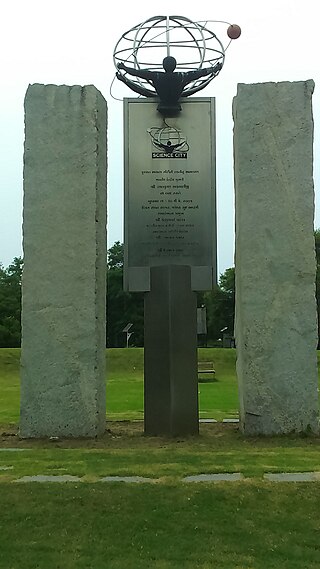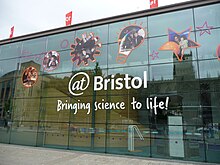
The Science Museum is a major museum on Exhibition Road in South Kensington, London. It was founded in 1857 and is one of the city's major tourist attractions, attracting 3.3 million visitors annually in 2019.

The National Science and Media Museum, located in Bradford, West Yorkshire, is part of the national Science Museum Group in the UK. The museum has seven floors of galleries with permanent exhibitions focusing on photography, television, animation, videogaming, the Internet and the scientific principles behind light and colour. It also hosts temporary exhibitions and maintains a collection of 3.5 million pieces in its research facility.
The Melbourne Museum is a natural and cultural history museum located in the Carlton Gardens in Melbourne, Australia.
The Oregon Museum of Science and Industry is a science and technology museum in Portland, Oregon, United States. It contains three auditoriums, including a large-screen theatre, planetarium, and exhibition halls with a variety of hands-on permanent exhibits focused on natural sciences, industry, and technology, while transient exhibits span a wider range of disciplines.

Science North is an interactive science museum in Sudbury, Ontario, Canada.

The Museum of Science (MoS) is a nature and science museum and indoor zoological establishment located in Science Park, a plot of land in Boston and Cambridge, Massachusetts, spanning the Charles River. Along with over 700 interactive exhibits, the museum features a number of live and interactive presentations throughout the building each day, along with scheduled film showings at the Charles Hayden Planetarium and the Mugar Omni Theater.

The Carnegie Science Center, soon to be The Daniel G. and Carole L. Kamin Science Center, is one of the four Carnegie Museums of Pittsburgh, Pennsylvania. It is located in the Chateau neighborhood. It is located across the street from Acrisure Stadium.

The Saint Louis Science Center, founded as a planetarium in 1963, is a collection of buildings including a science museum and planetarium in St. Louis, Missouri, on the southeastern corner of Forest Park. With over 750 exhibits in a complex of over 300,000 square feet (28,000 m2), it is among the largest of its type in the United States.

Glasgow Science Centre is a visitor attraction located in the Clyde Waterfront Regeneration area on the south bank of the River Clyde in Glasgow, Scotland. Queen Elizabeth II opened Glasgow Science Centre on 5 July 2001. It is one of Scotland's most popular paid-for visitor attractions. It is a purpose-built science centre composed of three principal buildings: Science Mall, Glasgow Tower and an IMAX cinema. It is a registered charity under Scottish law.

COSI, officially the Center of Science and Industry, is a science museum and research center in Columbus, Ohio. COSI was opened to the public on 29 March 1964 and remained there for 35 years. In 1999, COSI was moved to a 30000 m2 facility, designed by Japanese architect Arata Isozaki along a bend in the Scioto River in the Franklinton neighborhood. COSI features more than 300 interactive exhibits throughout themed exhibition areas.

The Fleet Science Center is a science museum and planetarium in Balboa Park in San Diego, California. Established in 1973, it was the first science museum to combine interactive science exhibits with a planetarium and an IMAX Dome (OMNIMAX) theater, setting the standard that most major science museums follow today. It is located at the east end of the El Prado Drive walkway, next to the Bea Evenson Fountain and plaza in central Balboa Park.

Shanghai Science and Technology Museum is a large museum in Pudong, Shanghai, close to Century Park, the largest park within the inner districts of the city. It is one of China's most-visited museums. It received 1,351,000 visitors in 2020, despite a fall of attendance of 72 percent from 2019 due to restrictions and reduced tourism imposed by the COVID-19 pandemic.

Telus World of Science Edmonton (TWOSE) is a broad-based science centre in Edmonton, Alberta, Canada, operated by the (non-profit) Edmonton Space & Science Foundation. The centre is located on the southwest corner of Coronation Park in the neighborhood of Woodcroft. The science centre houses 144,430 sq. ft. of public space and is the largest science centre in Western Canada. It is currently a member of both the Association of Science-Technology Centers (ASTC) and the Canadian Association of Science Centres (CASC).

The Maritime Aquarium at Norwalk is an aquarium located in the South Norwalk section of Norwalk, Connecticut.

The Houston Museum of Natural Science is a natural history museum located on the northern border of Hermann Park in Houston, Texas, United States. The museum was established in 1909 by the Houston Museum and Scientific Society, an organization whose goals were to provide a free institution for the people of Houston focusing on education and science. The museum complex consists of a central facility with four floors of natural science halls and exhibits, the Burke Baker Planetarium, the Cockrell Butterfly Center, and the Wortham Giant Screen Theatre. In 2022, the museum received 1,520,000 visitors, making it seventh on the List of most-visited museums in the United States, and was the third most-visited U.S. science museum. Much of the museum's popularity is attributed to its large number of special or guest exhibits.

Gujarat Science City is a science education and entertainment centre located in Ahmedabad, Gujarat, India. Opened in 2002 and expanded in 2021, it has an IMAX 3D theatre; exhibitions on science, space, energy park, life science park, planet earth, hall of science, musical fountain, thrill ride, plants, nature and robotics; an aquarium, an aviary and a butterfly park; as well as other facilities.

The Cox Science Center and Aquarium, formerly the South Florida Science Center and Aquarium, is a science museum located in West Palm Beach, Florida. Founded in 1959, the goal of the organization is to open every mind to science through the strategic programming of interactive exhibits and engaging community-based camps and events. The Cox Center has expanded since its creation and now houses over 50 hands-on exhibits, a planetarium, a 3000 square foot aquarium, a miniature golf course, and a large exhibit space that displays a temporary travelling exhibit. The Cox Center is a member of the Association of Science-Technology Centers program, which offers a membership that is redeemable at other ASTC science and technology centers around the world. The Cox Center occupies Dreher Park alongside the Palm Beach Zoo and offers deals for entrance into both facilities.

Science City, Kolkata is a science centre and science park in Kolkata, West Bengal, India. It is currently the largest science centre in the Indian subcontinent, containing a science museum, science park, and auditoriums. The centre was inaugurated in two parts, with the ‘Convention Centre Complex’ being the first on 21 December 1996, followed by the rest on 1 July 1997 by the then-prime-minister Inder Kumar Gujral. On 10 January 2010 the prime minister of India, Manmohan Singh, would attempt to get the second phase of Science City completed.

The Exploratory Hands-on Science Centre was a science museum in Bristol, England. The project was conceived in 1981 by Richard Gregory CBE, professor of neuropsychology at Bristol University, and was the first hands-on science museum in the United Kingdom. It was inspired by the creation of the Exploratorium in San Francisco which had opened some years earlier and which appointed him Osher Visiting Fellow in 1989. Prof. Gregory said: "As I see it 'hands-on science' is to stimulate interest in science and technology by presenting phenomena and experiments to show how things work at first hand.."

The ESO Supernova Planetarium & Visitor Centre is an astronomy centre located at the site of the European Southern Observatory (ESO) Headquarters in Garching bei München. It offers exhibitions, guided tours and planetarium shows that feature observations made by the telescopes of the European Southern Observatory.























